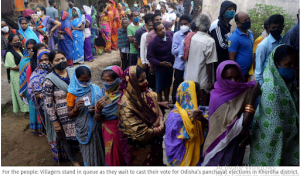11 Oct Panchayati Raj Institution: Grass without roots
The topic is based on Panchayati Raj Institution
The article tells how Panchayati Raj affects Indian Polity and Governance.
CONTEXT
It has been 30 years since the passage of the 73rd Constitutional Amendment Act, 1992. Though the act envisaged various reforms to strengthen grassroots democracy, very little progress has been seen and Panchayati Raj institutions still lack the power to function as democratic decentralized institutions.

Pic: Panchayati raj institution
THE 73rd CONSTITUTIONAL AMENDMENT ACT
- The system of Panchayati Raj existed even before the passage of the 73rd Constitutional Amendment Act. However, it was not uniform in all states and had several drawbacks.
- The Balwant Rai Mehta Committee was the first to recommend the establishment of a three-tier system consisting of gram panchayat at the village level, panchayat Samiti at the block level, and Zila Parishad at the district level.
- The L.M Singhvi committee and Thungon Committee later recommended granting constitutional status to the Panchayati Raj Institution.
- The 73rd Constitutional Amendment act was passed on these recommendations. It added a new Part-IX to the Constitution of India, ‘The Panchayats’, and consists of provisions from Articles 243 to 243 O. It has also added a new Eleventh Schedule to the Constitution that contains 29 functional items of the panchayats.
- The act provided for a three-tier system in every state, i.e, panchayats at the village, intermediate, and district levels.
- The act brought about a much-needed uniformity in the structure of The system throughout the country
- The act fulfills the constitutional goal envisaged in Article 40 of the Directive Principles of State Policy which lays down that the State shall take steps to organize village panchayats and endow them with such powers and authority as may be necessary to enable them to function as units of self-government.
- The Constitution mandates that panchayats shall be elected every five years and States shall devolve functions and responsibilities to them through law.
ISSUES WITH THE FUNCTIONING OF PANCHAYATS
- Inadequate devolution of grants: The amount of money set apart for them is inadequate to meet their basic requirements and function as decentralized democracy
- Inflexibility in spending: Even with the meager available amount, a major part is inflexible and cannot be spent as the Panchayat likes. The use of untied grants is also constrained through the imposition of various conditions.
- The limited base of taxes and user charges: These institutions have few avenues to raise their taxes and user charges.
- Understaffed: local governments lack adequate staff to perform even basic tasks.
- Vertically integrated departmental system: This system leads to a lack of responsibility as the staff hired by higher level departments is posted in local government on deputation and thus does not feel responsible or accountable to the local government.
- Not Holding regular elections: The Constitution mandates holding regular elections every five years for these institutions. However, this is often flouted. In Tamil Nadu, for example, panchayat elections have not been held for over two years now, resulting in the State losing finance commission grants from the Union government.
- Corruption: In the 1980s Rajiv Gandhi, then the Prime Minister of India, had said that for every rupee targeted towards welfare and poverty alleviation only a fraction, 15 paise, reached the intended beneficiary. This is the real state. In local government, often a nexus is made between elected representatives and officials where bribes are used for project clearances and development suffers.
- Lack of Infrastructure: Gram Panchayat often lacks its building and has to share the building complex with Anganwadi centers or schools. Further, they often do not possess basic amenities like drinking water and functional toilets. Many times, internet connections are also not functional.
WAY AHEAD:
To enable local government to truly function as a grassroots democracy, several reforms need to be undertaken to strengthen their functioning
- Empowering Gram Sabha: Gram Sabha is a body consisting of all persons whose names are included in the electoral rolls for the Panchayat at the village level. It should be made more active so that the institutions feel accountable to the people.
- 2nd ARC recommendation: It recommended a clear-cut demarcation of functions of each tier of The system for better governance.
- Bottom-up approach: The functions and planning should be bottom-up rather than a top-down delegation as Panchayats are better equipped to understand the needs and problems of rural India
- More taxation powers: Panchayats are hesitant to levy tax. They should be pushed to collect taxes and given more sources of tax collection to generate additional revenue.
- Creating a separate Bureaucratic cadre: This will ensure more accountability by the officials. Karnataka has created a separate bureaucratic cadre for Panchayats to stop the practice of deputation officials overpowering the elected representatives.
G.V.K. Rao Committee once called Panchayati Raj institutions “ grass without roots”. It is necessary to ensure this doesn’t happen and that local governance is strengthened to the core.
SOURCES:
Daily Current Affairs for UPSC
In the present day, Current affairs have become a source of gaining knowledge on national and international worlds. It is very important for any UPSC aspirant to read current affairs every day. Without going through current affairs, no one can pass their any competitive examination. So every UPSC examinee should read daily current affairs regularly for cracking the IAS exam. So get daily current affairs for the UPSC exam from Plutus IAS.




No Comments